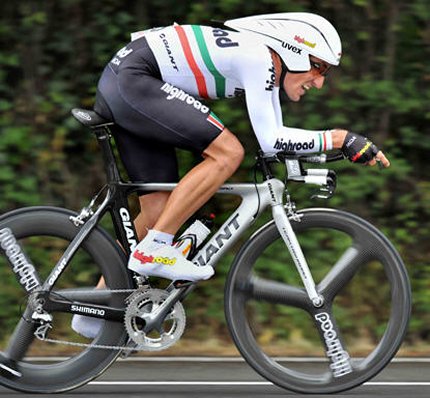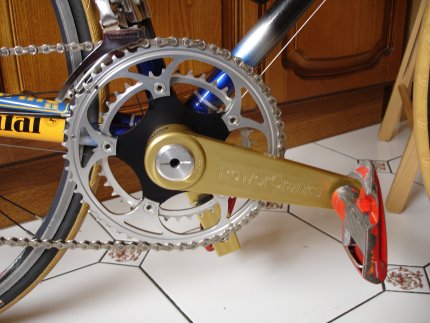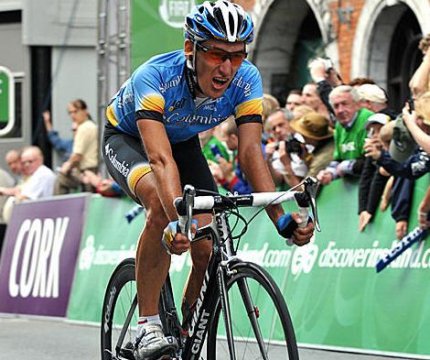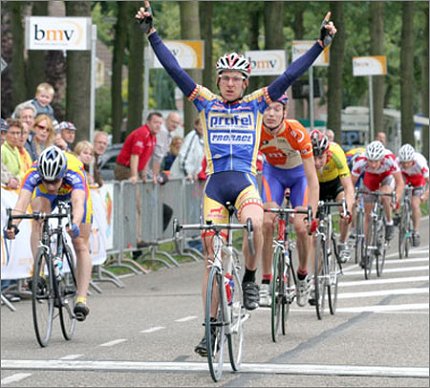In a sport where Grand Tours are won or lost by mere seconds, every advantage counts. It’s no secret that many top pros use PowerCranks as part of their training program, but most prefer to keep that secret. But we found three pros – Marco Pinotti, Dario Cioni, and Matt Brammeier who not only use the cranks, but were happy to talk to us about them.
In today’s Part I, we asked each about how they got turned on to PowerCranks, and their experiences getting started.
The 2008 Tour of Britain winner displayed his beautiful pedaling action to solo away from his group with 10km remaining and finish third on the final stage. The Englishman in the yellow jersey Russell Downing and his challenger Julian Dean chased, but couldn’t catch the powerful Giro d’Italia stage winner and three-time Italian Time Trial Champion Marco Pinotti.

It’s no secret in the Pro peloton that Marco is a big fan of PowerCranks – a training device that has been proven to increase a rider’s pedaling efficiency, and which creates physiological adaptations that actually reduce energy expenditure. They also help with recovery and muscle imbalances. In other words, they make you faster, and do this because they force you to use more muscles than you ordinarily do – and if you are using more muscle when you exercise, your VO2 max should be higher.
There’s been quite a few articles written about PowerCranks, but we’ve not seen much written anywhere concerning their use amongst the top tier, the elite professional riders and Tour de France competitors, and whilst the cranks aren’t used by the pro’s whilst racing, there are growing numbers of riders using them in training.

Although we’ve heard of many other top pros using PowerCranks for training, most are reluctant to admit it — preferring to keep PowerCranks as their own secret training device. But three pros not afraid to divulge some of their training info are Marco Pinotti of Team Columbia, Cadel Evan’s right hand man in the mountains Dario Cioni of Silence-Lotto our pal here on VeloVeritas, who has also been Italian time trial Champion in the past and has a top six Giro finish to his credit, and continental pro Englishman Matt Brammeier.
We figured this would be a great time to speak to Marco and Dario about their PowerCranks…

Hearing About PowerCranks
Marco kindly answered my questions the day after returning home from Ireland with the final yellow jersey in his bag. How and when did he become aware of the cranks?
“A friend of mine in Italy showed me the cranks last October, and explained how they worked – from that point I was interested. He had lived in the US for a time and he bought the cranks when he was over there. He let me try them for a few training rides — never more then an hour – and I was impressed about the possible improvements in pedal efficiency, so I discussed things with my trainer to decide whether it was a good idea to get a pair for myself.
“We agreed that they could definitely work for me and I talked with Andrew at PowerCranks to get it sorted out. I asked my team for a second bike to use the cranks with, and they did it.”
I asked Dario when we met at the recent Tour de France how he first came to know about PowerCranks:
“When I was with the Mapei-Quick Step Pro Development Team, alongside Pozzato, Fabian Cancellara, Michael Rogers and Charlie Wegelius in 2001, and there were a few guys using them… Stefano Garzelli and Paolo Bettini – they were using them a lot. I saw some samples at the time as well, but it wasn’t until I joined Liquigas in 2005 that I decided to try them for myself.“

First Rides
Dario told me about his initial experiments with them:
“Ahhhh! I was only able to do 50 metres! It was at the end of the season, so I was really well trained, and I thought I would just ride to the next village to see how they were. However, I ended up having to pedal back home, one leg at a time!“

Marco’s early attempts went a little better:
“The first time I used them was last October, and it was my friend’s set. I only did a few half-hours out on the road. Then, once I had my own personal pair I used them first of all just on the rollers, until I was able to do one hour without stopping. I practiced for two weeks, starting with 20 minutes sets and adding on five or six minutes every day.
“It took me two weeks and seven training sessions until I felt I was ready to use them on the road. I started to ride for one hour twice a week, and I added 30 minutes every week until I was able to do three hours. That’s about the max that I ride with the cranks.”
Another Pro rider who loves the cranks is Matt Brammeier, a 23 year old Englishman currently living, training – and winning – in Belgium for continental squad Profel Ziegler. Matt was recovering from a serious injury earlier this year and didn’t exactly enjoy his first rides on the cranks:
“I was a bit unsure of what to expect on my first ride so I decided to stay indoors on the rollers. Well, five minutes later I had to stop; my left hip flexor was so sore! I was pretty disappointed, but I was happy that I had found a weakness and also a way I could work on it.“

“So I planned to use the cranks every day and to work up in steps, eventually trying a proper training ride on them. It took me a couple of weeks of riding every day before I could get out on the road and feel comfortable. I could feel the burn in my hip flexors after about ten minutes on my left leg and about 30-40 minutes on my right during a one hour ride – and this was after two weeks of riding with them!”
Marco, Dario and Matt had experienced the same puzzle as every other cyclist – pro or not – that uses the cranks for the first time: “This feels weird – why does my leg not automatically bring the pedal back up?” The problem is, the brain hasn’t before had to liaise in this way with your legs, and with muscles – such as the hip flexors – that aren’t used much with ‘normal’ cranks, and that’s because these cranks are “independent” of each other.
With ‘normal’, fixed (that is, dependent) cranks, when you press one pedal down, the other pedal is brought up. That doesn’t happen with PowerCranks; unless you actively pull the pedal back up and round, your foot will remain at the bottom of the stroke – there’s no help from the other crank.
Each crank drives the chain but not the other crank – imagine doing one-legged drills all the time, with each leg working independently from the other. This is achieved by a unique clutch mechanism in each crank arm, and means that you use more muscles to make the rotation, and the weak spots in your pedal stroke are ‘trained out’, resulting in a stronger, more balanced and efficient cyclist.

The first ride on PowerCranks is certainly an eye-opener, and it’s recommended that you begin with the cranks on your home-trainer, until you have become accustomed to the different neuro-muscular sensations. Furthermore it’s suggested that high cadences aren’t attempted — it’s better to focus on form initially. Once you can comfortably ride PowerCranks for five minutes non-stop and the strange feeling has faded away, you are ready to take them out on the road.
There are other reasons for practicing with the cranks indoors first – clipping in and out of them takes a little time to get used to, because you have both pedals at the bottom of the stroke when you push off, and getting out the saddle is a little different from normal too – you find yourself using your arms and shoulders more to stabilise things, as Dario found:
“I have noticed is that you simply cannot ‘go easy’ out of the saddle, you have to go hard. On the Spin trainer it’s easier to get out of the saddle though, and sometimes on the Spin I will do one legged pedaling, just to ease the monotony.”
In a training device however, all these points are actually good things.
In Part II we’ll discover how Marco and Dario integrate PowerCranks into their training, and hear how Matt uses them to recover from serious injury.



